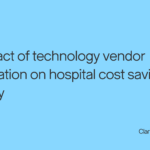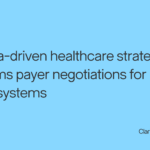A critical goal in delivering good healthcare is to curb healthcare costs while providing quality outcomes. Is our healthcare system designed to do that? As healthcare costs continue to rise and quality outcomes become increasingly important, it’s essential to examine the economic models that drive our healthcare system. In this post, we’ll explore the limitations of current healthcare economic models and discuss the need for an intermediary to promote systemic change, encourage participation in incentive programs, and ultimately deliver better care at a lower cost. The issue is that payers and the providers are basically set up in an economic system where there aren’t enough savings to draw people to enter incentive programs in a holistic, programmatic way. You need lots of people brought in to make this work. Let’s say that you’re saving $10, and you’re paying $5, and the insurance premium costs $2. Okay, now there’s $3 of savings. Well, $3 for one patient, no one cares. Three dollars for 100,000 patients, they may start to care. Three dollars on 1,000,000 patients starts getting the right attention. So how do we create and implement an incentive model that really moves the needle on spend and quality? A payer’s goal, just like any other company, is to grow revenue and increase profit margin while delivering the best services to their members. Right now, payers face a variety of economic choices on how to do that. Here are a few of the most popular examples: Fee-for-service The most common model is fee-for-service. In this case, the provider sends the payer a bill and gets paid after the treatment is delivered on an approved rate schedule. The upside to this is patients receive highly valued services because the provider can offer several options. The downside is that it incentivizes providers to offer unnecessary services, and since neither the provider nor the patient is held fiscally responsible, this leads to rising healthcare costs. Integrated Delivery Networks (IDN) Integrated delivery networks are organizations or a collection of doctors who collaborate with other local healthcare facilities and form one governing board. Incentives for physicians are based on salary plus bonuses. Individual delivery networks tend to be much more focused on the health and wellness of patients. But, because they are so focused on cost reduction, they don’t necessarily offer the most cutting-edge therapies. Take Kaiser Permanente, for example; they built an infrastructure long ago where they developed housing along with a healthcare system during World War II for shipbuilders and dock workers. The incentive was to keep people healthy so they could work. It’s efficient because everybody’s incentives are aligned. It’s what I call the closed-loop system. Pay for Performance There’s a much different scenario when it comes to pay for performance since a payer is responsible for paying the incentives of whatever program is in place. This model is the financial incentive that lets payers and providers focus on achieving quality outcomes. However, there is an inherent risk aversion to putting incentive programs in place because payers must generate a significant amount of medical spend savings to afford the incentives and the reduction in medical spend. Incentive programs have proven difficult to implement because, right now, they are not designed to make immediate payments to providers. What’s the impact of an incentive that can take up to 18 months to be rewarded to the provider? That’s why we built Clarify Advance. It provides the insights to do things like move semi-elective or elective surgeries from the hospital to a higher-value outpatient setting, which we know saves about $5,000. That’s so much money that you can afford to pay the doctor $1,000-$2,000 to make that decision. Managed Service Organizations (MSOs) An MSO is a company that provides non-clinical services to ambulatory care facilities and medical practices. It gives the healthcare provider what they need to form a solid relationship between contracted payers and the government. This allows providers to focus on population health and can help reduce overall medical spend. On the other hand, in this scenario, the providers have less flexibility and reduced decision-making ability within their practice. The Need for an Intermediary in Healthcare Economic Models Now that we have a rundown of some of the most popular models, you might be wondering: Where do independent practitioners fit in? What about all the doctors who aren’t part of an IDN or an MSO but a group of 15 colleagues who banded together to form an orthopedic practice in Dallas — and want to participate differently? They need an option to safely stay in business, generate a predictable revenue cycle, and feel confident about the outcomes they deliver. What they need is an intermediary. An intermediary is an organization that helps providers deal with government contracts, patients, and vendors. Historically, MSOs acted as the intermediary. Intermediaries are essential because they help providers deal with government contracts, patients, and vendors. They can take on challenges that an individual provider or small practice likely can’t handle on their own. For starters, an intermediary can standardize the contracts for the practice. An intermediary can give the providers a transparent way to understand what their prospective economics would be, based on their historical performance and trajectory of improvement. An intermediary can show them what the cost of the stop-loss insurance premium would be and what the time horizon would be over which they would be paid. Here are four things an intermediary must do to help providers operate independently and shift their economics toward greater value: I believe the ideal future for a healthcare economic model is based on a marketplace with an intermediary between payers and providers. That’s because the current arrangements are at odds with the individual participants — particularly when they are individual physicians. By addressing the challenges faced by individual practitioners and aligning incentives, intermediaries can foster a more efficient and cost-effective healthcare system that prioritizes patient outcomes.
- Author Details





